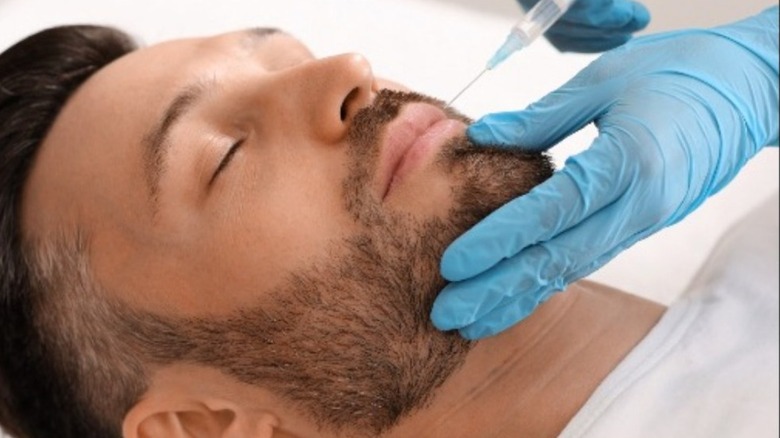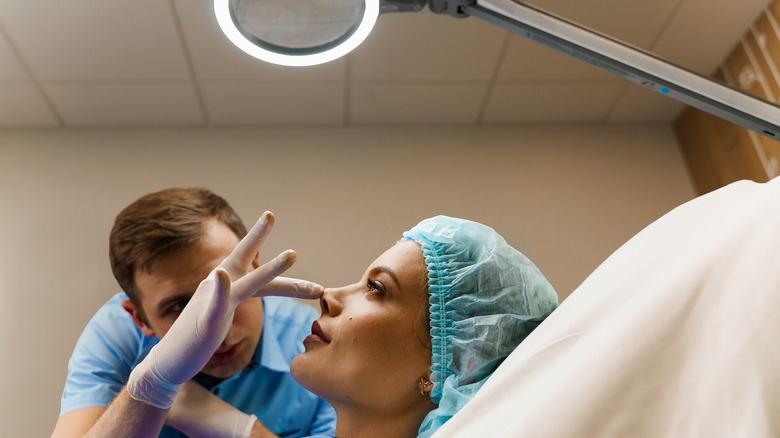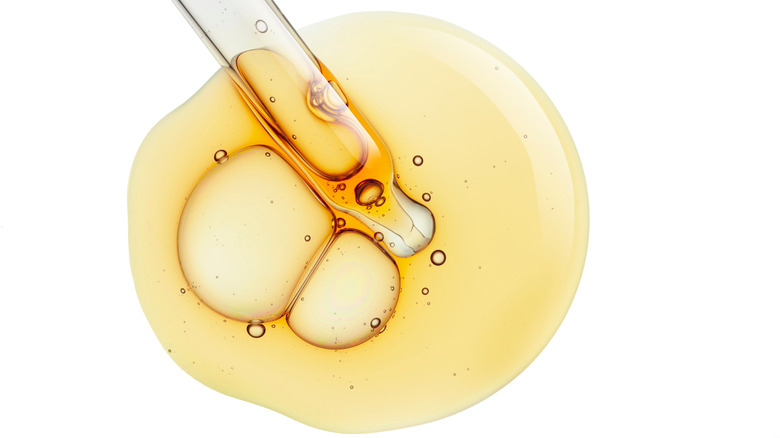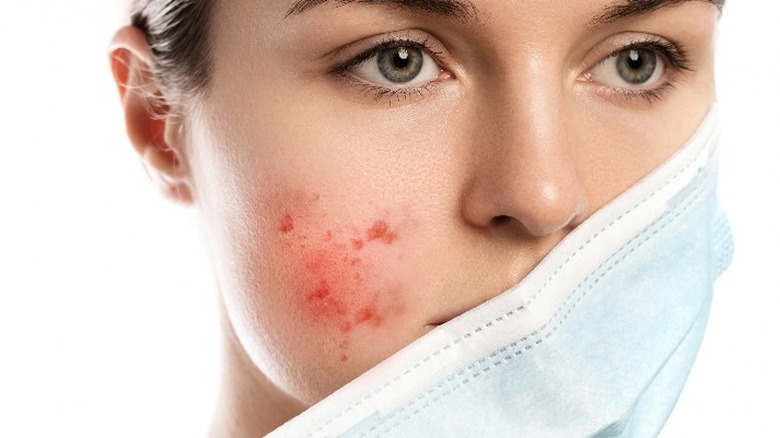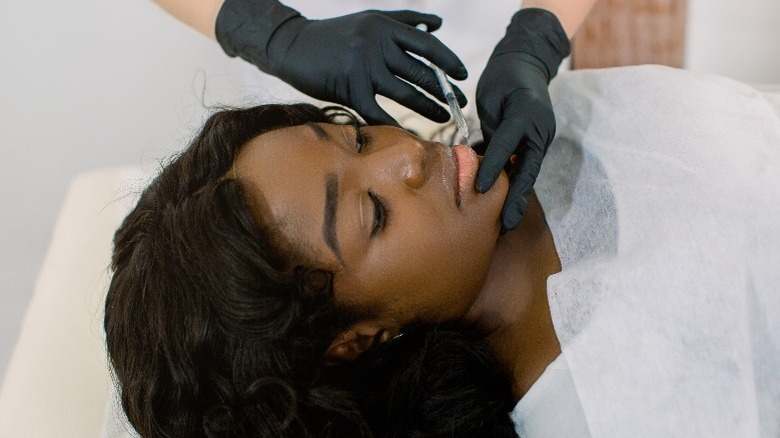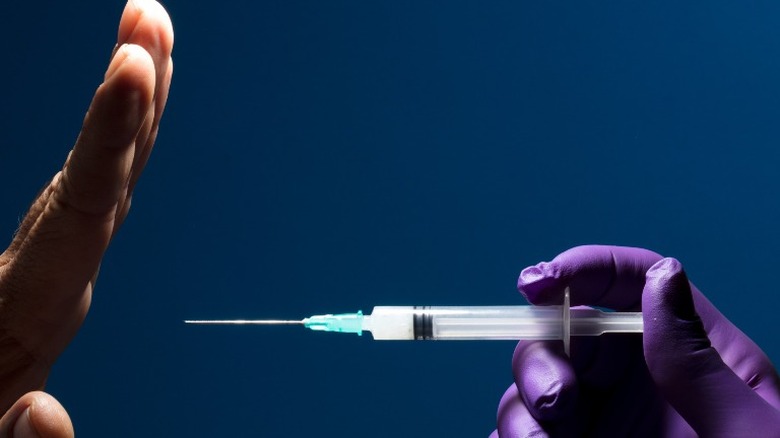Everything You Should Know Before Getting Facial Fillers
Looking and feeling good is one of the major contributors to increased confidence — and the face plays a huge role in this. Enhancing different aspects of your face and skin can improve your overall look and make you feel more comfortable, presentable, and attractive (via Piper Berry). Dermal fillers are slowly rising to the top as the most preferred way to boost facial appearance. According to a 2020 survey published by the International Society of Aesthetic Plastic Surgery, various facial filler (also called dermal filler) procedures using substances like hyaluronic acid, Poly-L-lactic acid, and Calcium Hydroxylapatite (CaHa) saw a 24.1% increase in demand from 2016 to 2020.
In 2021, the facial fillers market had a value of over $5 billion (per Fortune Business Insights). With its meteoric growth over the years and the constantly rising demand, by 2029, chances are, the market value will have skyrocketed to almost $9 billion. The success of facial filler procedures is as a result of the mostly safe and effective way they provide to make your appearance look more youthful and radiant. From smoothing wrinkles to softening the appearance of scars, facial fillers can help deal with issues that keep your face from shining its entire glory.
Keep in mind, however, many myths and misconceptions about facial filler procedures exist and they've tainted the procedures' general public image. And while the procedures may not be entirely rewarding for everyone, many of the rumors circulating around are not true. To clear the mist for you and paint a clearer picture, we'll be exploring everything you should know before getting facial fillers.
How do dermal filler procedures work?
Essentially, getting facial fillers involves four steps (per American Society of Plastic Surgeons). The first step involves evaluating your face and determining suitable areas to inject the fillers. The evaluation focuses on the general appearance of your face and skin color. The doctor then proceeds to mark parts of your face they feel are good entry points for the fillers and snap photos of target areas.
The entry points often vary with different skin tones. Speaking in an interview with Allure, Dr. Michelle Henry, a New York-based dermatologist and dermatologic surgeon, explains that people with darker skin tend to age differently from those with lighter skin. People with a lighter skin tone get more wrinkles on their faces as they age, while the skin of people with a darker tone sags and sinks in.
The second step involves cleaning the injection spots using cleansing agents and administering a topical numbing agent or local anesthesia (via American Society of Plastic Surgeons). In the third step, the doctor strategically injects the fillers into your face through the marked spots. Finally, after adding the fillers, your doctor will evaluate the results and may massage the area to adjust it. When they finish the evaluation and adjustment, the marked spots get rubbed off your face. Some swelling may be visible and you may feel slightly uncomfortable after the procedure. The specialist performing the procedure may give you an ice pack to help deal with the two after-effects. You may also receive some recommendations like keeping away from sunlight and avoiding makeup to hasten your recovery process (via National Health Service).
Facial fillers come in different types
Many substances used as fillers look like gel and are easily absorbed and broken down by the body after a while — making the procedure a temporary solution, according to the U.S. Food and Drug Administration (FDA). Follow-ups are necessary to maintain the effects over a long period. However, some fillers have a permanent effect on the body. Between these two types, only four fillers have been FDA-approved for use in dermal fillers procedures.
The first one is Hyaluronic acid, a form of sugar found in body tissues like the cartilage and skin. These fillers last for about six months to a year. Calcium hydroxylapatite is another approved mineral-based filler that's commonly used in hand and face procedures, and which stays put for around one and a half years. The third filler is Poly-L-lactic acid, a synthetic polymer that blends in with living tissue in the body. It can hold on for around two years.
For a permanent fix, the approved filler is Polymethylmethacrylate beads. Like Poly-L-lactic acid, it doesn't affect living tissues. However, your body cannot absorb it, hence its long-lasting effects. The FDA found the mentioned fillers to be effective and well tolerated for participants in clinical studies on dermal fillers. Ensure your doctor uses one of the approved fillers. According to Johns Hopkins Medicine, your own fat taken from your body may also make a good filler. However, based on research, the results of fat injections are inconsistent, and success is dependent on individual factors.
They may pose some adverse effects
Speaking to CNN Health, Dr. Hani Rayess from Wayne State University School of Medicine says, "fillers are very safe and ... the most common complications are swelling and infection, which are relatively benign complications, with no permanent side effects." An article in The Journal of Cutaneous and Aesthetic Surgery also notes that other mild effects that may be visible after several days of the procedure include itching, redness, and bruising.
More serious side effects include visible nodules, lumps, pain, allergic reactions, and even tissue necrosis. Stroke and artery blockage accompanied by blindness are also possible side effects, although they occur on rare occasions. A few months after having the procedure, you may be at risk of experiencing inflammation, position change of filler, and scarring too. It is always good to be on the lookout for any of the mentioned side effects a few days to months after getting dermal fillers.
The FDA cautions people on using silicon gel, liquid silicone, and other unapproved fillers, as many negative side effects can be caused by these products. You should also avoid getting dermal fillers anywhere other than from a qualified health specialist.
They may come with a hefty price tag
There is no standard price for facial filler procedures in any given region. Prices vary and are often influenced by factors like the type of filler used, where you get the procedure done, how many syringes you'll need, competition, and the health specialist doing the job (via ProMD Health). On average, you may end up parting with $400 to $4,000 for the procedure going by the factors mentioned.
According to the American Society of Plastic Surgeons, using human fat as a filler is perhaps the most expensive option, followed by Polymethylmethacrylate. Keep in mind, the average estimated cost is only for one syringe. When you factor in additional syringes along with the follow-ups and retouch procedures, the overall amount increases over time. Dermal filler procedures are generally not covered by health insurance. The good thing is, some health centers do provide affordable payment plans for this kind of procedure.
Facial fillers are not the same as Botox
Given that they are both injections commonly used for cosmetic purposes, you may wonder if facial fillers and Botox are basically the same thing (via Medical News Today). However, there are fundamental differences between the two.
For starters, facial fillers work by injecting fillers into various parts of the face to increase the volume lost by aging that causes wrinkles and creases. On the other hand, Botox uses a purified form of bacteria that acts on facial muscles, paralyzing them in order to reduce facial movements that cause wrinkles and lines to show up on the face. Essentially, the procedures deal with two different types of wrinkles. Botox targets dynamic wrinkles — wrinkles influenced by the movement of muscles. For instance, Botox may soften the wavy lines on your forehead, the two horizontal parallel lines between your eyebrows, and wrinkles around your eyes. Facial filler procedures deal with static wrinkles — the wrinkles that appear as a result of face volume loss and skin sagging.
Another difference between the two is that, compared to Botox — which brings short-term results — facial fillers are reliable for a longer term. Botox effects fade after about four months, while you can go for years with facial fillers without needing additional treatments (via Healthline).
You should take precautions before getting dermal fillers
The FDA recommends proceeding with caution when it comes to facial filler procedures. Not all procedures and products out there with "highly effective" labels on them will give you the results you're after. Among the things the FDA advises you to avoid are needle-free injection objects that use high pressure to place the filler. These can cause grievous injuries and even permanent damage to your skin, eyes, or lips.
Moreover, you should stay away from products that encourage a DIY approach rather than working with a qualified health specialist. Such fillers may be counterfeit or contaminated and may put your health at risk. You're also advised to ask your health specialist about the fillers they'll be using and make an effort to read the product label. Also, inquire about the location on your face where each type of filler will be used if your doctor recommends several types of fillers. Avoid taking alcohol and anti-inflammatory drugs a day before the procedure, and ensure you eat a good meal before your appointment (per Laser SkinCare Center Dermatology Associates). These precautions will increase your safety and help you avoid dizziness as your treatment is in progress.
Individual factors will determine the type of procedure and your results
The type of filler your doctor will use on you and the success of the results depend on many individual factors. Since each filler has its unique injection depth, density, and texture, your doctor should evaluate your face and discuss your goals with you to determine which procedure will yield the best results (per American Board of Cosmetic Surgery). Facial anatomy plays a huge role in determining the best approach to take for any facial filler procedure, as does the particular area in which you are seeking treatment. As an article published in the Journal of Cutaneous and Aesthetic Surgery states, the different zones on your face — the lips, nasolabial fold (the lines running from your nose to both ends of your mouth), the glabella area (area between your eyebrows), and the periocular area (the area around each eye from upper eye fold to lower eye fold) — each demand specific considerations.
Facial fillers may not be everyone
Before scheduling a facial filler procedure, your doctor will perform an evaluation to determine if it's the right course of action for you. People who stand the best chance of benefitting from a facial filler procedure are those who are healthy. If you have any health issues that may interfere with your recovery process after the procedure, your doctor may advise you to consider other options (via the Skin Center of South Miami). Likewise, if you smoke, your lines are not that deep, or if you have facial problems that other procedures could handle much better, your physician may recommend alternate treatments.
If you're also allergic to any of the substances that fillers come with including lidocaine (the anesthesia used to manage pain in procedures), or you're pregnant or nursing, you should avoid facial fillers (via the West Institute). Moreover, if you have a bacterial, fungal, or viral infection that affects the potential injection spot (such as herpes simplex virus that affects your lips, for instance), it's not recommended that those areas become official injection spots for your procedure.
They may require regular touch-ups
When it comes to maintaining the results from your dermal filler procedure, you'll need to see your doctor every so often for touch-ups (per Derma Skin Institute). Remember your body breaks down the fillers over time, and the injected areas begin to lose volume again and wrinkles begin to reappear if no follow-ups happen several months after the procedure. Ensuring you go for the aftercare program in time will help keep everything in place. Some fillers can last up to two years, while others for only a few months. So, before you leave the health center after having your procedure, confirm which filler the doctor used on you and how long it'll take before it's necessary for you to go back to restore it in areas where it'll have lessened.
According to the Laser and Dermatologic Surgery Center, other factors like your lifestyle, your metabolism, and the quantity of filler added to your face may also contribute to determining how long the filler will last on your face. Don't get surprised when you realize that you may need to check with your doctor earlier or later than you had initially planned. Ideally, for fillers that take six months to a year to wear out, touch-ups after every three to six months are the best way to go (via Beverly Fischer). For those that stay for up to two years, you can have touch-ups done after one and a half to two years.
People who get facial fillers may experience some pain
It's worth noting that you may experience some pain when getting facial fillers (per ePlasty). Although you may receive anesthesia before the procedure begins so as to tone it down, some pain may still persist. Your doctor may use vibration devices during a dermal filler procedure to further reduce the pain. These devices likely block pain signals from getting to the central nervous system, hence the pain-relieving effects. The lips and the nasolabial fold are the areas where patients tend to feel the most pain when getting dermal fillers.
However, some people experience even more pain a few hours, days, or weeks after the procedure due to complications. For instance, a 2010 case report published in The Journal of Clinical and Aesthetic Dermatology describes the experience of a woman in her early 50s with a track record of successful dermal filler procedures who experienced complications a few months after a particular procedure. She felt pain, accompanied by swelling and a nodule. After notifying her doctor, she received medication like minocycline, prednisone, and methylprednisolone, and got injected with enzymes like Hyaluronidase over a few weeks, and the pain and other problems disappeared.
Successful facial fillers give you a natural look
After a successful facial filler procedure, the results should present a natural look and everything on your face should complement each other nicely. People who aren't aware you got facial fillers shouldn't be able to tell the difference between your face with and without the fillers (via Look Lovely London). For instance, one particular client of Escape Aesthetics, a UK-based medical aesthetics practice, expressed happiness with dermal fillers when the results she got filled in the gap she felt existed on her face, without going beyond. She wanted her facial features to pop and become more defined, and that's what the successful procedure delivered.
According to the National Laser Institute, successful procedures happen when there is good communication between the client and the doctor, and when an experienced doctor performs the procedure. If these key factors don't play out seamlessly in your case, chances are you may end up with having unpleasant results. Some signs of a poorly done procedure include unevenness of the face, swellings, and other complications that may be what you hoped for (via Lazaderm).
With some facial fillers, the results are reversible
Some people may go through dermal filler procedures and end up feeling like the doctors added a slightly higher quantity of filler than the required one, or they may have a bad reaction to the treatment and need the filler removed (via the Dermatology Online Journal). Depending on the injection method, these people may be able get their procedures partially or entirely reversed. An injection of enzymes like hyaluronidase helps to reverse the results. Hyaluronidase dissolves fillers like hyaluronic acid effectively without affecting your dermal structure or skin (via Kaya Cosmedica).
For temporary fillers like hyaluronic acid, you can always alter results if you aren't too happy with them. They're usually the safest and most preferred type of fillers for those who fear getting the wrong permanent results (via the American Society of Plastic Surgeons). When you work with fillers that last a lifetime like Polymethylmethacrylate and the results don't please you, it may be challenging to modify the final look, even with options like corrective surgery (via Dermatology Online Journal). Managing the side effects that arise from permanent fillers may also prove to be very tough. That's why you have to be completely certain and confident of your doctor's skills and expertise if you decide to take the permanent filler route.
How to choose a doctor perform your facial filler procedure
In an interview with Allure, Corey Hartman, a certified dermatologist in Alabama says, "Patients, hands down, need to ask about credentials and level of education because that's going to speak to our breadth of knowledge." In terms of credentials, one thing you want to look for is that the dermatologist or plastic surgeon performing your procedure is board-certified. Hartman also strongly emphasizes choosing a doctor who's well versed in facial anatomy and in how race and ethnicity affect facial appearance and cosmetic goals. You might gauge your doctor's skills in this area, as well as their overall aesthetic, by asking to see their portfolio of before-and-after photos of past clients. If the "after" photos don't show the kind of look you're going for, that doctor may not be a good match for your needs. Additionally, it helps to ask how often a doctor does facial fillers and how many corrections they've performed on clients who've had poorly done procedures from other doctors.

